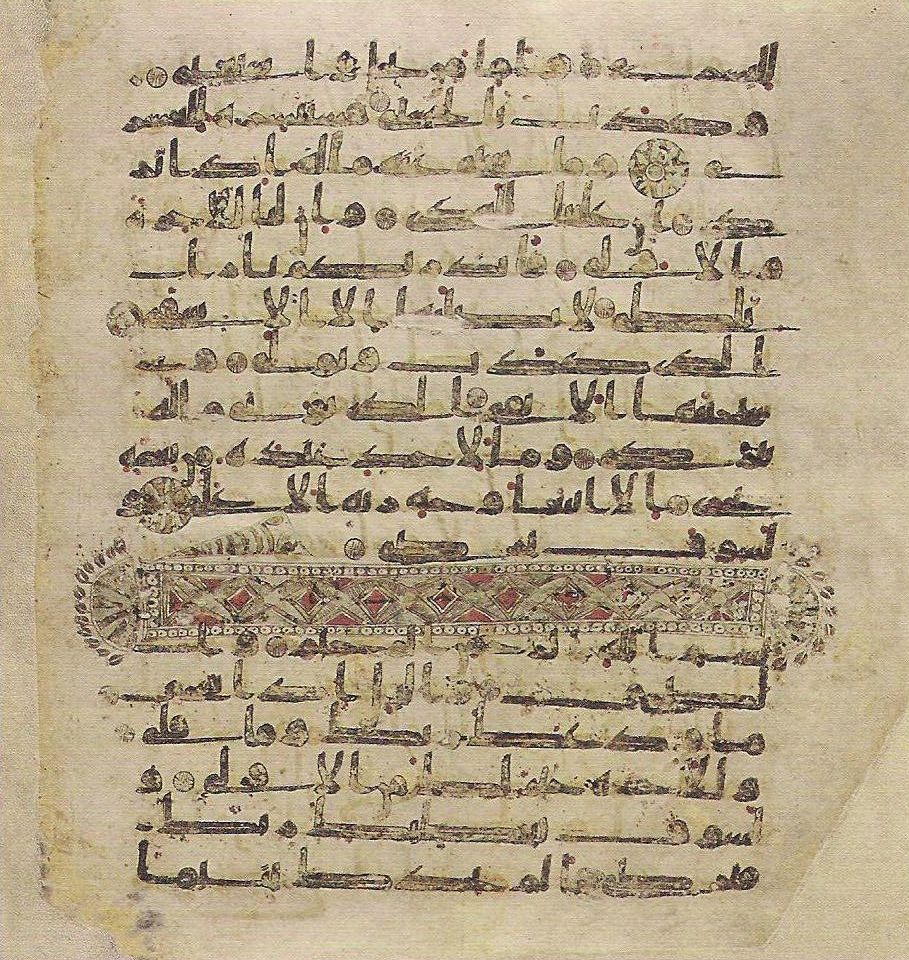Topkapi manuscript on:
[Wikipedia]
[Google]
[Amazon]
 The Topkapi manuscript or Topkapi Quran is an early manuscript of the
The Topkapi manuscript or Topkapi Quran is an early manuscript of the
/ref> Also cf. E. İhsanoǧlu: "An examination of the Topkapı Muṣḥaf shows that it was written with a developed kufic script. The shape of the letters does not confirm to the writing style of the early Muṣḥafs attributed to Caliph ʿUthmān, which were written on vellum in his period and therefore known as the Muṣḥafs of Caliph ʿUthmān. ... Apparently this Method of Abū al-Aswad al-Duʾalī nvented after the death of Caliph ʿUthmānwas carefully followed in placing the vowel marks of the Topkapı Palace copy. Single dots were placed in red ink above, beside or below the letters." (Altıkulaç, al-Muṣḥāf al-Sharif (Preface), page 9). "According to the evaluation of Munadjdjid, neither this Muṣḥaf nor the Muṣḥafs located in Tashkent, al-Mashhad al-Ḥusayn in Cairo and in the Museum of Turkish and Islamic Works in Istanbul were the Muṣḥafs attributed to Caliph ʿUthmān; however considering the differences in their script, the centuries when they were copied and their different dimensions, they must have been copied from the Muṣḥafs attributed to Caliph ʿUthmān. For this reason, each of them was called the (Muṣḥaf ʿUthmān)" (Altıkulaç, al-Muṣḥaf al-Sharif, page 80).
 The Topkapi manuscript or Topkapi Quran is an early manuscript of the
The Topkapi manuscript or Topkapi Quran is an early manuscript of the Quran
The Quran (, ; Standard Arabic: , Classical Arabic, Quranic Arabic: , , 'the recitation'), also romanized Qur'an or Koran, is the central religious text of Islam, believed by Muslims to be a revelation in Islam, revelation from God in Islam, ...
dated to the early 2nd century AH (i.e., early- to mid-8th century AD).
This manuscript is kept in the Topkapi Palace Museum, Istanbul
Istanbul ( , ; tr, İstanbul ), formerly known as Constantinople ( grc-gre, Κωνσταντινούπολις; la, Constantinopolis), is the List of largest cities and towns in Turkey, largest city in Turkey, serving as the country's economic, ...
, Turkey
Turkey ( tr, Türkiye ), officially the Republic of Türkiye ( tr, Türkiye Cumhuriyeti, links=no ), is a list of transcontinental countries, transcontinental country located mainly on the Anatolia, Anatolian Peninsula in Western Asia, with ...
. It is traditionally attributed to Uthman Ibn Affan
Uthman ibn Affan ( ar, عثمان بن عفان, ʿUthmān ibn ʿAffān; – 17 June 656), also spelled by Colloquial Arabic, Turkish and Persian rendering Osman, was a second cousin, son-in-law and notable companion of the Islamic proph ...
(d. 656). Similar illuminations can be found in the Dome of the Rock
The Dome of the Rock ( ar, قبة الصخرة, Qubbat aṣ-Ṣakhra) is an Islamic shrine located on the Temple Mount in the Old City of Jerusalem, a site also known to Muslims as the ''al-Haram al-Sharif'' or the Al-Aqsa Compound. Its initial ...
in Jerusalem, the Umayyad Mosque
The Umayyad Mosque ( ar, الجامع الأموي, al-Jāmiʿ al-Umawī), also known as the Great Mosque of Damascus ( ar, الجامع الدمشق, al-Jāmiʿ al-Damishq), located in the old city of Damascus, the capital of Syria, is one of the ...
in Damascus and other Umayyad
The Umayyad Caliphate (661–750 CE; , ; ar, ٱلْخِلَافَة ٱلْأُمَوِيَّة, al-Khilāfah al-ʾUmawīyah) was the second of the four major caliphates established after the death of Muhammad. The caliphate was ruled by the ...
monuments. The size of this manuscript is 41 cm x 46 cm. It contains more than 99% of the text of the Qur'an. With only two pages (23 verses) lacking, this manuscript is the closest to the complete text of the Quran. Mehmed Ali Pasha, Governor of Egypt, sent this manuscript to the Ottoman Sultan Mahmud II
Mahmud II ( ota, محمود ثانى, Maḥmûd-u s̠ânî, tr, II. Mahmud; 20 July 1785 – 1 July 1839) was the 30th Sultan of the Ottoman Empire from 1808 until his death in 1839.
His reign is recognized for the extensive administrative, ...
as a gift in the 19th century (CE).
The paleographic assessment indicates that the Topkapi manuscript comes closest to those writings that date back to the 8th century. (cf. the examples in Déroche: Abbasid, page 36).Kodex Topkapı Sarayı Müzesi at corpus coranicum/ref> Also cf. E. İhsanoǧlu: "An examination of the Topkapı Muṣḥaf shows that it was written with a developed kufic script. The shape of the letters does not confirm to the writing style of the early Muṣḥafs attributed to Caliph ʿUthmān, which were written on vellum in his period and therefore known as the Muṣḥafs of Caliph ʿUthmān. ... Apparently this Method of Abū al-Aswad al-Duʾalī nvented after the death of Caliph ʿUthmānwas carefully followed in placing the vowel marks of the Topkapı Palace copy. Single dots were placed in red ink above, beside or below the letters." (Altıkulaç, al-Muṣḥāf al-Sharif (Preface), page 9). "According to the evaluation of Munadjdjid, neither this Muṣḥaf nor the Muṣḥafs located in Tashkent, al-Mashhad al-Ḥusayn in Cairo and in the Museum of Turkish and Islamic Works in Istanbul were the Muṣḥafs attributed to Caliph ʿUthmān; however considering the differences in their script, the centuries when they were copied and their different dimensions, they must have been copied from the Muṣḥafs attributed to Caliph ʿUthmān. For this reason, each of them was called the (Muṣḥaf ʿUthmān)" (Altıkulaç, al-Muṣḥaf al-Sharif, page 80).
References
Quranic manuscripts Topkapı Palace {{Islam-stub